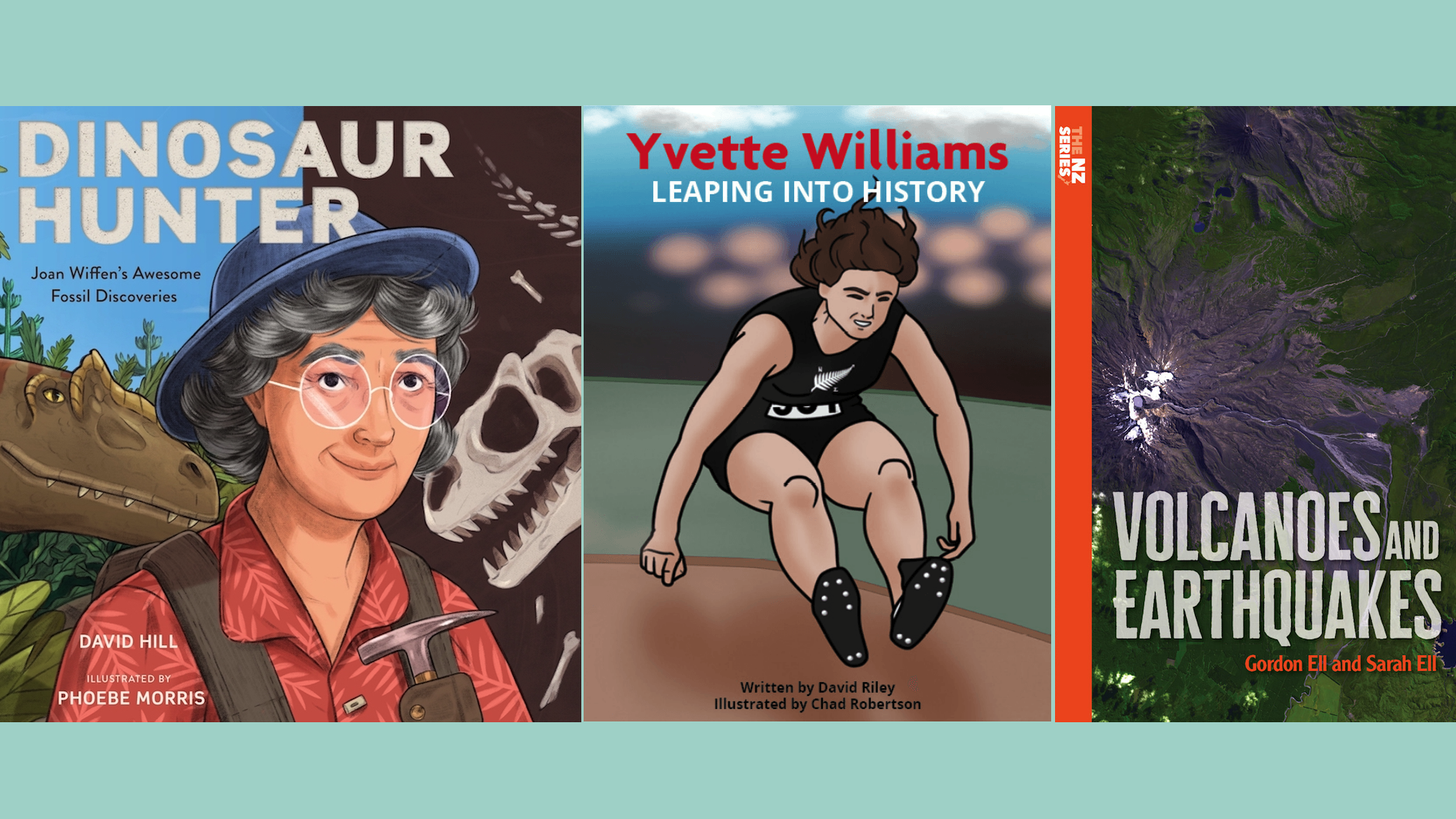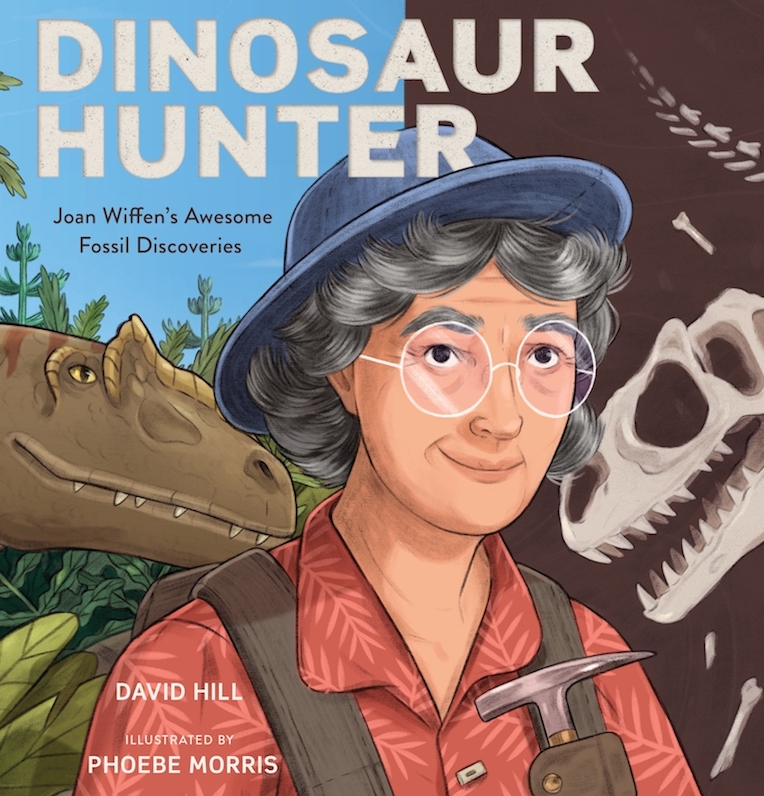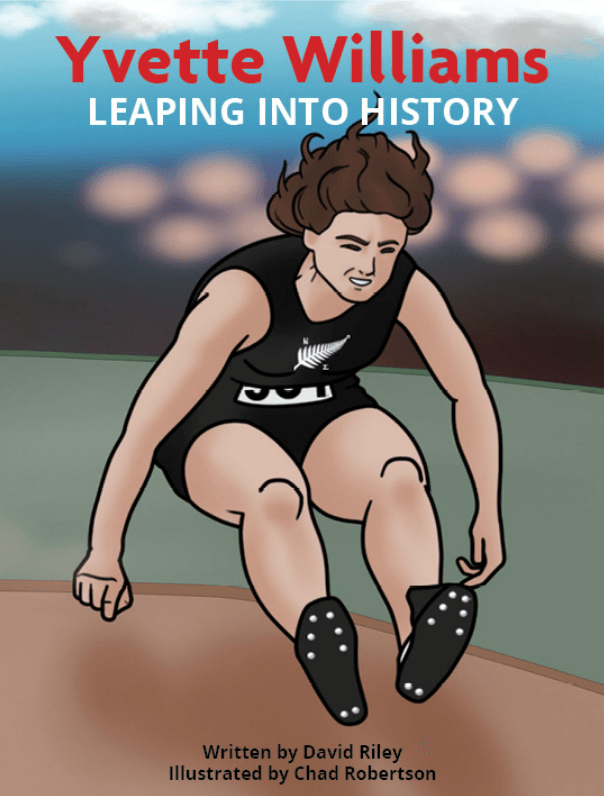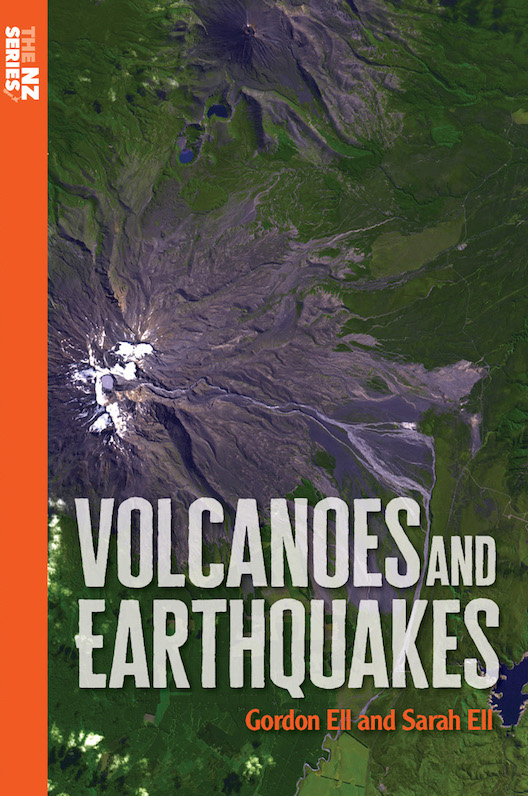Here’s a peek at three new non-fiction titles, as reviewed by Esther Kiernan (with a little input from her nine-year-old son). With two biographies – a palaeontologist and a sporting superstar – and one geology book, there’s something for every variety of young fact fiend.

Dinosaur Hunter: Joan Wiffen’s Awesome Fossil Discoveries by David Hill and Phoebe Morris (Penguin Random House)
This is the fifth picture book in a series of biographies of heroic New Zealanders, and it’s good to see the series including more diverse heroes. Joan Wiffen was an amateur scientist – a collector and researcher of dinosaur fossils – who began her career relatively late in life. If it was a challenge to make the science career of an older woman engaging for children, the book doesn’t show it. This is a high-quality, hard-cover production that pairs rich illustrations with the skilful writing you’d expect from David Hill.
Dinosaurs always help, of course, and the idea of the anachronistic creatures sharing space on the page with Joan got a giggle from my nine-year-old, though it may confuse younger readers. The dog, who alone can see them, is a lovely addition. Phoebe Morris uses muted, earthy tones that suit the subject matter, and she plays with light and shadow particularly well.
…the idea of the anachronistic creatures sharing space on the page with Joan got a giggle from my nine-year-old…
Dinosaurs are also used to lure the reader in from the outset. The book begins by describing them in the present tense: ‘Pterosaurs with giant wings sweep across a shallow bay.’ The fossilisation process is condensed into one page, and then we read, ‘She doesn’t know it yet, but Joan Wiffen has just found her first dinosaur.’ Now that readers are hooked, the story transitions smoothly to the past tense to tell us about Joan’s life.
The book paints a picture of a woman who was determined and passionate, a true life-long learner, whose interests were shared by her husband, Pont, and several unnamed friends and family members. It follows her interest in fossils, beginning as a young girl, through to developing an interest in geology as an adult, searching for dinosaur fossils, educating herself through books, finding, extracting, and identifying fossils, and finally being recognised by experts for her achievements. Prior to her work, dinosaurs were not thought to have existed in Aotearoa.
Adults will be inspired by Joan’s determination and courage in following an interest later in life despite lacking formal education. Children will be inspired to nag their mothers to let them hunt for fossils in the creek.

Dinosaur Hunter: Joan Wiffen’s Awesome Fossil Discoveries
By David Hill
Illustrated by Phoebe Morris
Penguin Random House NZ
RRP $25
Yvette Williams: Leaping into History by David Riley and Chad Robertson (Reading Warrior)
This biography tells the story of Yvette Williams, New Zealand’s first female Olympic gold medallist. It’s lovely to see that she was visited by the author and was aware of this book being written before her death in April this year, aged 89.
The book begins with a nail-biting description of Yvette’s 1952 Olympic attempt – two ‘no jumps’. Will she make the third and avoid disqualification? We’ll have to wait and see, because there’s a lot to learn about her life first. David Riley is no stranger to writing biographies, and he does this one well. My son observed that there is a good balance between the specific (for example, direct quotes from Yvette) and the general (bless his year 5 teacher).
We learn about Yvette’s amusing wrestling matches with her brother and read anecdotes about climbing that are likely to have come from conversations with the woman herself. Her achievements were all the more impressive because she did not have access to gyms or fancy training equipment. Her training involved running uphill in army boots, lifting children and sandbags with her legs, and fishing shot puts out of muddy puddles. We learn about her wide range of athletic skills – she represented New Zealand not just in long jump but also in discus, hurdles, javelin, shot put, and basketball.
Her achievements were all the more impressive because she did not have access to gyms or fancy training equipment.
I found the sudden switch to present tense for the Olympic section jarring. I think it would have worked better if kept in the past tense. The notes would work better if they were in text boxes, and I found the illustrations disappointing. Although they capture movement well, they are inconsistent in style – the weight and colour of the outlines varies, and one illustration almost looks like manga. More photos could help, especially for the double-page spread of female Olympic gold medallists.
The book does a good job of portraying what Yvette’s achievements meant to the New Zealand public and to her personally. I smiled at Walter Nash’s gift of the world’s longest jumper for the world’s longest jumper! The book doesn’t mention Yvette’s posthumously awarded damehood, and it doesn’t go into her post-athletics life. Still, it is an interesting and inspiring record of the sporting achievements of a truly remarkable New Zealander.

Yvette Williams: Leaping Into History
By David Riley
Illustrated by Chad Robertson
Reading Warrior
RRP $27.99
Volcanoes and Earthquakes, by Gordon and Sarah Ell (Oratia Books)
There are many books on volcanoes and earthquakes in most libraries, so what sets this one apart? Firstly, it’s up-to-date – it includes the 2016 Kaikōura quakes. It’s New Zealand-focused, and it’s well-pitched for students in years 7 to 10. It’s the second book in a series aimed at this age group.
Two-thirds of the book is dedicated to volcanoes, and this section seems more in-depth than the earthquake section. We learn about volcanic shapes, colours, lahars, geysers, hot springs, mud pools, fumeroles, and terraces, and about New Zealand’s active, dormant, and extinct volcanoes. The information is presented in a readable and logical way. Although there are many wonderful colour photographs and diagrams, I found myself wishing for more – for example, I didn’t know what the Sugar Loaves were until I looked them up online, and there are no close-ups of different types of volcanic rock.
We learn about volcanic shapes, colours, lahars, geysers, hot springs, mud pools, fumeroles, and terraces…
The information in the earthquake section will be more familiar to most readers, as many of these events happened during our lifetimes. I found the chapter on measuring quakes confusing – it contrasts ‘moment magnitude’ with ‘modified Mercalli’ or ‘felt intensity’, but the following table contrasts modified Mercalli with the Richter scale, which the text says was replaced in the 1970s by moment magnitude. However, the rest of the text gives a good summary of major New Zealand earthquakes.
There are a few editing niggles, such as the lack of any macrons in Māori words, technical terms sometimes introduced without being defined, and the number of miner deaths on White Island being ten in one place and eleven in another (an inconsistency that is not resolved by searching online, as sources differ). The term ‘a‘ā is written aa and not defined. There is an impressive index, but a glossary would have been a useful addition. The fact files are nicely laid out and contain interesting information.
On the whole, this is a well-written and beautifully designed book that will be a useful addition to intermediate and secondary school libraries.

Esther Kiernan
Esther used to work as an editor for Learning Media. She has four children and lives in Wellington.



